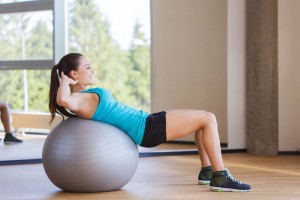
Stability balls are a popular and versatile piece of fitness equipment used in gyms, homes, physical therapy sessions and even the workplace. Also known as exercise balls, Swiss balls, Physio balls, and balance balls, the purpose of the stability ball is to improve balance, muscle tone and core strength.
Stability balls are filled with air and come in a variety of sizes. They are lightweight, durable, and inexpensive — but are they really effective? Here are some of the benefits of incorporating stability balls into your exercise routine:
Improve flexibility. Use a stability ball to warm up and stretch your muscles before a workout. Improved flexibility can reduce risk of injury and keep your muscles and joints functional.
Expand range of motion. Stability balls can be used to expand range of motion during certain exercises, such as crunches and sit-ups.
Strengthen core. When used properly, stability balls can strengthen the core (abdominal and lower back muscles). These muscles are used to perform daily activities. A strong core helps to protect the back and stabilize the whole body, including the spine, pelvis, hips and shoulders.
Improve balance. Simply sitting on a stability ball engages the stabilizer muscles in your core. Training on a ball forces your body to improve balance to complete the exercises, and can also be beneficial in keeping a healthy posture.
Exercises to do on a stability ball
Below are a few ways you can use a stability ball to train various muscle groups:
Leg curls. Lie on your back with your feet elevated on the ball. Begin with your legs straight, your shoulders and arms on the ground, and your back and hips off the ground. Using your heels, draw the ball toward your body and bring your knees to a 90-degree angle. Return to the starting position and repeat.
Plank. Place your hands firmly on the ball with your arms straight. With your back and legs straight, activate your core and shoulder muscles as you balance yourself in place. For an added challenge, bring your knee forward toward the ball, alternating legs.
Straight leg bridge. Lie face up with your arms at your side, your legs straight and your feet on the stability ball. Contract your glutes to raise your hips up off the floor until your body forms a straight line from ankles to shoulders. Keep your torso engaged throughout the movement.
Push-up. Get into the push-up position with your hands firmly on the ground, arms straight and your toes on the stability ball. As you perform the push-up, keep your core engaged to maintain your balance.
In addition to exercise, stability balls are also often touted as a healthier alternative to sitting in a chair. Proponents of sitting on an exercise ball say that because the abdominal muscles must be constantly engaged, core strength, posture, balance and stability will improve. Some also say that sitting on a stability ball can increase calorie burn.
However, opponents to using a stability ball as a desk chair argue that an office chair should take pressure off the lower back and support the arms, while sitting on a stability ball for prolonged periods can worsen back pain and fatigue.
Before you begin using a stability ball for exercise or in place of your desk chair, consult with your physician to find out if a stability ball will be beneficial for you.





